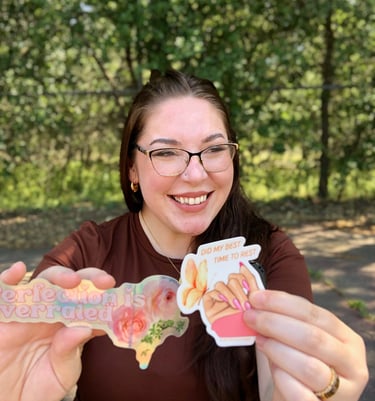
Anger Is Not the Enemy: How Righteous Anger Clears Emotional Clutter
10/14/20254 min read


We’re taught to fear anger.
To tuck it away, smooth it over, and say “I’m fine.”
Especially as women, caregivers, and peacemakers, we learn early that anger is dangerous—that it makes us “too much,” “ungrateful,” or “unhinged.” But what if anger isn’t the villain we’ve made it out to be? What if it’s actually the part of us that loves us enough to fight for change?
Anger isn’t destruction—it’s data.
And when we learn how to read it, it can become one of the most cleansing forces in our emotional (and even physical) lives.
The Emotional Spiral: Why Anger Is a Step Up, Not a Step Back
In healing work, I often picture emotions as a spiral.
At the very bottom sits apathy—that flat, hopeless feeling where you’re too depleted to care. One level above is resentment—a quiet bitterness that says, “I can’t believe this is still happening.”
And then comes anger.
It’s fiery, alive, uncomfortable—but it’s movement. It’s energy.
It means your nervous system is waking up.
Feeling anger is not a regression; it’s progress. It’s your body finally saying:
“Something about this no longer fits me. Something needs to change.”
When you’re coming out of survival mode, the reappearance of anger can feel like a threat—but it’s actually a sign of safety. Your nervous system has decided you’re stable enough to feel again. That’s not failure—that’s healing.
Anger as Nervous System Energy for Action
From a biological standpoint, anger is a burst of mobilizing energy. It’s our body’s natural way of generating fuel to move, to protect, to act. It’s the nervous system flooding us with adrenaline so we can stand up, speak out, or walk away.
That’s why suppressed anger so often shows up as exhaustion, burnout, or even physical clutter—because all that energy that was meant to move gets trapped instead.
You know that sudden wave of irritation that makes you want to scrub the kitchen, throw away half your closet, or rearrange your furniture? That’s your nervous system trying to metabolize stuck energy. Cleaning can actually become a nervous-system-regulating act—it channels emotional energy into tangible movement and creates clarity where chaos used to be.
The Dust of Neglect: When Resentment Settles In
Think of resentment like the dust we ignore in our homes.
It starts small, almost invisible. Then one day, sunlight hits just right and you see particles floating everywhere—and realize how long it’s been since you truly looked.
When we suppress our anger, we do the same thing internally. We keep shoving little moments of hurt, disappointment, and unmet needs into the corners of our minds. Over time, they collect. They dull our energy. They make the air heavy.
Cleaning becomes more than a chore—it’s symbolic. Stirring up the literal dust mirrors what happens emotionally when we face the feelings we’ve avoided. The goal isn’t perfection; it’s movement. You don’t have to clear everything at once. You just have to stop pretending it isn’t there.
Righteous Anger vs. Reactive Anger
Not all anger is the same.
Reactive anger lashes out. It burns bridges, blames, and hurts. Righteous anger is different—it’s anchored in clarity.
Righteous anger says, “This doesn’t align with my values.”
“This is crossing a boundary.”
“This deserves to be seen.”
You can feel anger without fear, without shame, and without losing your softness.
It’s possible to be both angry and kind, fiery and gentle, assertive and forgiving.
The difference lies in the pause—the deep breath before reacting, the decision to let anger inform you, not control you.
When you pause long enough to ask, “What is this anger trying to show me?”—you turn chaos into clarity. You realize anger is simply your body’s way of saying, “I matter.”
Let Anger Move You Toward Clarity
The beauty of anger is that it moves.
It wants to go somewhere. It’s energy begging for direction.
When you channel that energy intentionally, it becomes a force for healing rather than harm.
Try this:
Move your body. Take a walk, dance, clean one surface. Let the energy have an outlet.
Journal your anger. Write the raw words, no filters. Let yourself see the truth.
Tidy a space that mirrors your frustration. The junk drawer, the bathroom counter, your inbox. Physical clarity helps emotional clarity land.
Speak what needs to be spoken. Sometimes the most healing act is simply saying, “That wasn’t okay,” out loud—even if no one else hears it.
You don’t need to suppress anger to be peaceful.
You need to move it through you to reach peace on the other side.
Anger, Forgiveness, and Coming Home to Yourself
There’s something sacred about realizing you can be angry and loving in the same breath. That you can raise your voice, set a boundary, or take up space without becoming “too much.”
Each time you allow yourself to feel anger fully—and respond with self-awareness instead of self-judgment—you rewrite your inner wiring. You show your nervous system that it’s safe to express, safe to feel, safe to release.
And if you do snap or overreact?
That’s human. That’s where self-forgiveness comes in.
Every act of repair—cleaning up the mess, apologizing, resetting—is part of the same process. The goal was never to be perfectly calm or endlessly patient. The goal is to stay connected to yourself, even in the messy middle.
Clean Anger, Clear Energy
Anger, when honored instead of feared, is one of the cleanest emotions there is.
It cuts through confusion, clarifies what matters, and reminds you where your boundaries live.
Suppressing it only makes it stagnate—inside you, in your relationships, and in your home. But when you let it breathe? When you move it through your body and your environment? It transforms.
You don’t have to fear your anger.
You can trust it.
You can feel it fully and still stay soft.
Because peace isn’t the absence of anger—it’s what waits on the other side once you’ve let it move through.
Your home doesn’t just hold your stuff. It holds your stories, your energy, your emotions.
So when you feel the next wave of irritation rising, instead of pushing it down, ask yourself: “What truth is this trying to clear?”
Then open the window. Move a little.
Let your space, and your soul, breathe again.

🌿 About the Author
Hi, I’m Jocelyn—the heart behind Tidy On Your Terms. I help people create home systems rooted in self-love, not shame. My work blends cleaning and organizing with nervous system support, forgiveness, and flexibility—because your space should feel like peace, not pressure.
📖 Bring Encouragement Into Your Home
Looking to bring some encouragement into your space?
Check out the paperback Tidy On Your Terms here—a soft, supportive introduction to our approach.




